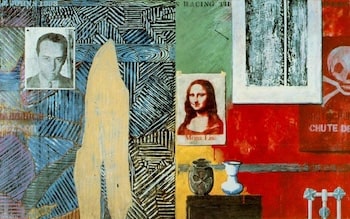Racing Thoughts, 1983 by Jasper Johns

Sometimes we try to listen to our thinking, as if we were able to pause and take hold of our thoughts, manipulating them like external objects. But thoughts can also be intrusive, especially
when they run or race ahead of our listening and comprehension, We may feel as if we no longer actively control them; instead, we have too many and are reduced to suffering them.
Polyattentiveness may not be enough to keep the situation pleasurably interesting. The term racing thoughts refers to a psychological condition that often accompanies anxiety; in its most extreme
manifestations, it indicates a serious manic disorder and borders on the so-called loose association that characterizes schizophrenia. A person's mind "races" uncontrollably from one thought or
topic to another, usually with some kind of logical connection, but too quickly for any link to be put to practical use. The experience is unsettling, and to outside observers the pattern of
thought, the form of its expression, may seem incoherent. Perhaps Johns would nevertheless accept the form, observing it while maintaining his equanimity and curiosity. It would be another case
of "how my mind must move."
In 1983 Johns titled a bipartite composition using a stenciled inscription at the top of one side: Racing Thoughts. Around this time or shortly before, the artist suffered a mild form of
racing thoughts and also became acquainted with the name of the condition. He was amused to learn that it existed as a general syndrome, beyond his specific bout with it. Because he tends to
conflate personal preference and material necessity, active and passive causes, it would be un-Johnsian to assert a causal link from the biographical fact of his anxiety to his title
Racing Thoughts, or still further to the thematic content of his image. This would mistake a "fact," a coincidental conjunction, for a "representation," a kind of rule. The associations s
hould remain loose - not in the pathological sense (schizophrenia) but merely in a logical sense, Johns' title is itself a kind of racing thought, a stimulus to the continuing movement of an
attentive mind.
Racing Thoughts depicts a number of objects and pieces of art, all of which were familiar occupants of the artist's studio and domestic environment in one form or another (for instance,
an avalanche warning sign existed as a reproduction from a Swiss newspaper, and a Mona Lisa by Leonardo da Vinci).
In addition, the painting is also laced with less obvious art-historical in-jokes. Some have argued that a bizarre beige shape at the painting's center may be a direct allusion to the flayed flesh
seen in Last Judgement by Michelangelo. Meanwhile, stenciled like a sign, the title of the painting
refers to an independent topic of Johns' interest. The stenciling itself forms a visual object in the total array, which has no obvious thematic order. "They must be things I was thinking of,"
he has commented, tautologically.
